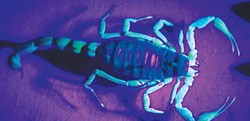[
{
"name": "Top Stories Video Pair",
"insertPoint": "7",
"component": "17087298",
"parentWrapperClass": "fdn-ads-inline-content-block",
"requiredCountToDisplay": "1"
}
]
Skeletons in My Closet
I collected my first insect when I about 6. It was a honeybee from the iceplant in my front yard. That was followed by a bumblebee. My folks encouraged me with books and supplies. Together they made me a butterfly net. Now in my 60s, I have accumulated a lot of bug books and insect lore. Those first specimens are long gone, along with all but the last frame of insects I collected. The specimens in that one are largely from when I lived in Nevada almost 30 years ago.
Nowadays, I collect digital photos, since they take less room and don't require hours of careful preparation or space. My computer hard drive contains more than 40,000 images, while one glass frame holds fewer than 100.
Insects have sturdy exoskeletons, external cuticles made of the durable chiton that endures almost indefinitely. Properly prepared and cared for, insect bodies can last centuries.
While physical specimens can provide valuable scientific information if carefully catalogued, my last frame is not among those and now, years later, I can barely remember the time and place of collection of a few individuals. A nice thing about having the creatures preserved is they pose better than their living, moving and potentially stinging and biting counterparts.
Illumination
Despite tipping over every rock and lifting every piece of peeling bark on my property over the years, I have yet to find a scorpion. So I've started carrying a black light when I take my dogs out in the evening. Scorpions are known to fluoresce under UV, which is a curious thing since they seldom come out during the day. One explanation is that they absorb the UV and retransmit the energy as green light so their photo receptors (they have some in their tails as well as their eyes) can pick up the signal. Since they are "negatively phototactic" (they avoid light), this might help protect them from overexposure.
Whatever the explanation, scorpion hunters put this characteristic to good use finding them with black lights. I was surprised a few nights ago when I saw something not just glowing, but glowing brilliantly in the redwood needles. Cautiously — because although our local scorpions aren't known to be dangerous, no sting is to be taken lightly — I poked around with a stick and uncovered one very active millipede.
Knowing those are relatively harmless, I picked it up and carried it back to my house. In regular light it was a rather dull tan color, but under my flashlight it glowed as bright as any mineral specimen I have ever seen. I even managed to take a short video. I sent photos to BugGuide.net and got a reply that it might be an immature member of the family Xystodesmidae which, of all things, contains Harpaphe haydeniana, the cyanide millipede, a species I mentioned not being able to get a photo of in my post a few weeks ago.
It was suggested I raise it and see if it changes colors when it reaches maturity. I am terrible at that and seldom ever get a specimen to survive, so I opted to return it to where I found it, hoping it would make more so I might see them in the future.
Comments
Showing 1-1 of 1
more from the author
-
HumBug: Early Spring Pollinators
- Apr 12, 2020
-
HumBug: A Recipe for History
- Apr 5, 2020
-
HumBug: Bugs in the City
- Mar 29, 2020
- More »
































